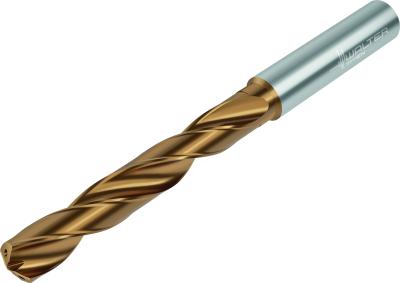
The DC160 X∙treme Evo Advance solid-carbide universal drill from Walter, features exceptional positioning accuracy. This is achieved with its innovative new thinner web at the point; rapid guidance in the hole due to the advanced positioning of the margins; and high productivity in many different applications.
The Advance lineup of products is one of three categories to Walter solid carbide drills—Advance, Perform, Supreme. The Advance tools are products which are efficiently balanced between price and performance. The Perform tools are products that provide an economical solution with focused importance on price. The Supreme designation indicates the highest level of technology and performance available.
The DC160 X∙treme Evo achieves improved point geometry by using a deeper and larger chip gash at the point, requiring less torque and feed force, thus improving tool life. This also moves the second margin forward allowing it to engage sooner and improves true position of the hole and boosts hole quality. The DC160 is a four-margin drill which provides improved stability in uneven entrance and exits, as well as cross holes or interruptions. It has an improved TiSiAlCrN/AlTiN multi-layer coating and is available in 3, 5, 8 and 12 x Dc. The new drill can be used with or without internal coolant depending on size. The whole range covers diameters: 3–20 mm, for 3, 8 and 12 x Dc along with 3–25 mm, for 5 x Dc (all diameters 1/8-3/4-inch nominal range).
The DC160 can be used with all ISO material groups and in a wide variety of applications, such as inclined entries and exits, drilling holes close to the edge of the workpiece, or convex and concave surfaces. It can also be used with all of the major machine tool types, including both horizontal and vertical machining centers and in lathes. The new drill can be applied with or without internal coolant.
Contact Details
Related Glossary Terms
- centers
centers
Cone-shaped pins that support a workpiece by one or two ends during machining. The centers fit into holes drilled in the workpiece ends. Centers that turn with the workpiece are called “live” centers; those that do not are called “dead” centers.
- coolant
coolant
Fluid that reduces temperature buildup at the tool/workpiece interface during machining. Normally takes the form of a liquid such as soluble or chemical mixtures (semisynthetic, synthetic) but can be pressurized air or other gas. Because of water’s ability to absorb great quantities of heat, it is widely used as a coolant and vehicle for various cutting compounds, with the water-to-compound ratio varying with the machining task. See cutting fluid; semisynthetic cutting fluid; soluble-oil cutting fluid; synthetic cutting fluid.
- feed
feed
Rate of change of position of the tool as a whole, relative to the workpiece while cutting.
- web
web
On a rotating tool, the portion of the tool body that joins the lands. Web is thicker at the shank end, relative to the point end, providing maximum torsional strength.

